- Joined
- Jun 28, 2011
- Messages
- 238
- Reaction score
- 480
Back from the vacation and got a bit of time to work on the boat. What I came up with for a boiler feed pump is possibly the ugliest item I have made so far. I have to get better at planning ahead. My design on the fly attitude has served me well but more and more I see the need for plans. My lack of patience for drawing out designs is the biggest reason I haven't looked into CAD. I should since fusion 360 is free but that's a whole new skill for my already full brain. I have discovered if I learn something new I forget something old !
Anyway back to the modern art looking pump. I used 3/16 rubber balls for the check valves and cut the metal so that both ball seats are not buried in a bore of some kind. I did that because I haven't had great success with getting these types of check valves to seal well and I thought being able to inspect the seat and adjust it out in the open would help. I didn't take many pictures for these parts, I was just keeping my head down and cutting metal, kind of winding down from the trip overseas. I still need to fit a mounting bracket and plumb it in but quick test with no real load is promising. I will take an exploded view picture of the pump and post it to be more clear on the design
Pete
View attachment ImageUploadedByModel Engines1495805545.439394.jpg
View attachment ImageUploadedByModel Engines1495805557.174520.jpg
View attachment ImageUploadedByModel Engines1495805573.005599.jpg
View attachment ImageUploadedByModel Engines1495805588.811940.jpg
View attachment ImageUploadedByModel Engines1495805604.582578.jpg
Anyway back to the modern art looking pump. I used 3/16 rubber balls for the check valves and cut the metal so that both ball seats are not buried in a bore of some kind. I did that because I haven't had great success with getting these types of check valves to seal well and I thought being able to inspect the seat and adjust it out in the open would help. I didn't take many pictures for these parts, I was just keeping my head down and cutting metal, kind of winding down from the trip overseas. I still need to fit a mounting bracket and plumb it in but quick test with no real load is promising. I will take an exploded view picture of the pump and post it to be more clear on the design
Pete
View attachment ImageUploadedByModel Engines1495805545.439394.jpg
View attachment ImageUploadedByModel Engines1495805557.174520.jpg
View attachment ImageUploadedByModel Engines1495805573.005599.jpg
View attachment ImageUploadedByModel Engines1495805588.811940.jpg
View attachment ImageUploadedByModel Engines1495805604.582578.jpg





![MeshMagic 3D Free 3D Modeling Software [Download]](https://m.media-amazon.com/images/I/B1U+p8ewjGS._SL500_.png)
































































